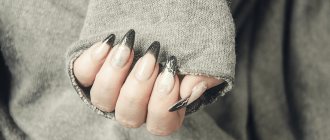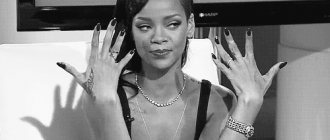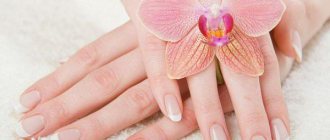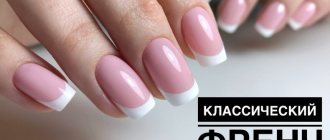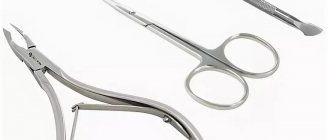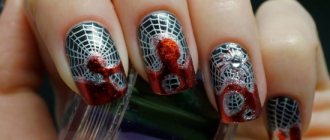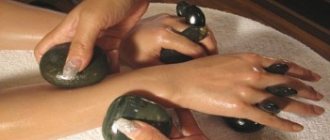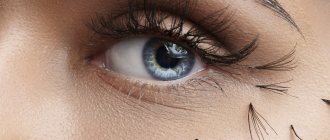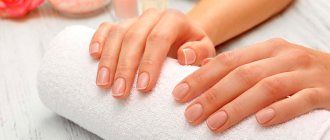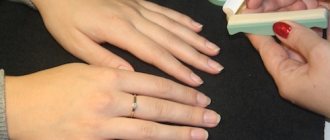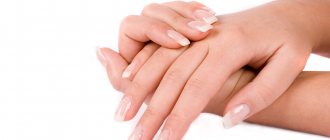From this article you will learn:
- What is European manicure
- What is the difference between classic and unedged manicure?
- Which manicure is better
- What tools and products are needed for a European manicure?
- How to do a European manicure yourself
A well-groomed woman always stands out with beautiful hands and a neat manicure. An untrimmed procedure will allow you to forget about tweezers and scissors, injuries to the nail plates and cuticle treatment. Thanks to its safety and painlessness, it is gaining more and more fans around the world. Let's figure out together what the technology for performing European manicure is, and what is the secret of its popularity.
The origin of unedged manicure
European manicure has many millions of fans around the world. This technique is loved not only by girls, but also by men who are accustomed to monitoring the condition of their hands and nails. The unedged technique first appeared in France, which is why European manicure is sometimes called French.
European manicure is suitable for everyone, without exception, and for people who have close capillaries or thin skin on their hands, experts recommend using only French manicure.
Miss Marlene is the woman thanks to whom the technology of performing European manicure began to gain popularity. Since the first half of the twentieth century, it became known to a small circle of people, and several decades ago this type of manicure began to gain increasing popularity, first in Western countries, and a little later throughout the planet.
What is European manicure and how does it differ from classic manicure?
European manicure is a relatively new, but quite popular type of nail care, which costs the fair sex “little blood.” But jokes aside, in fact, this method of caring for nails and cuticles is not in vain recognized as the safest in the world, and therefore it is widely used not only on the European continent, but also in the USA, as well as Asian countries.
Another name for European manicure is unedged, and all because the technology for its implementation does not involve the use of piercing or cutting tools. By the way, the history of the emergence and promotion of unedged manicure around the world begins in the times of Ancient Egypt, when it was customary to use an infusion of healing henna to care for the cuticle. Later, in 1830, the tradition was revived, thanks to a painful hangnail on the royal finger of the famous French monarch Louis Philippe. After an operation to remove part of the cuticle, the ruler decided to carefully care for the skin around the nails and the side ridges, regularly anointing them with overseas essences. This fashion quickly spread to nearby lands, making well-groomed hands the calling card of the aristocracy.
European manicure in the modern understanding of the process also appeared in France, but already at the end of the 20s of the 20th century. A native of France, Juliette Marlene, played a significant role in its spread. This extravagant lady was the personal stylist of the legendary star Marlene Dietrich, whose nails were especially problematic, fragile and brittle, and whose cuticles were painfully thin and bleeding. The enterprising Mrs. Juliet invented her own type of manicure, which eliminates the need to cut off the overgrown skin. Somewhat later, this stellar method spread around the world and acquired the name “European manicure.”
We have already talked about how to properly care for your nails, from which the conclusion follows - it’s easy to do a manicure, without even putting in much effort. But at the same time, many beginners are afraid of the fact of cutting or traumatizing the delicate epidermis, and for good reason, because even an experienced, practicing master in a salon can accidentally catch the skin. Therefore, an unedged manicure is the best way out of the situation, which does not require special skills and knowledge. European unedged manicure is recommended for those with fragile, brittle nails that are prone to splitting, as well as for those whose cuticles grow especially quickly. It is logical that the more often you cut it, the sooner it will grow back and will require you to go to the beauty salon again.
Types of European manicure
There are several varieties of European unedged manicure; all the differences come down to the type of softening of the cuticle and skin of the hands. Beauty salons offer four methods:
- Wet - to soften the skin around the nail, use a warm bath with the addition of a special lotion, which nourishes and softens the skin. You need to constantly add hot water to the bath so that the temperature is forty degrees.
- Hot - slightly similar to the first type, but the procedure uses a cream or lotion without water. For such a procedure, it is necessary to have a device that will maintain a constant temperature of the product. The temperature should be no more than 50 degrees, keep your fingertips in the bath for about ten minutes. After completing the procedure, the remaining lotion should be rubbed into the nail plates and skin of the hands. This type is suitable for people with fragile nails and wounds on the fingertips.
- Dry is an excellent option for creating a quick manicure. To remove dead skin cells and soften the skin, a special product is first applied. It may look like a cream or gel. The product is applied in small portions to each nail, then distributed throughout the skin around the nail. For damaged nails, this method is not beneficial, since it does not provide nutritional procedures.
- Brazilian manicure perfectly nourishes the skin around the nail, but also rejuvenates the skin of the hands. SPA manicure involves the use of ceramides, nourishing and aromatic oils, as well as hand massage after completion of the procedure. For this type of manicure, gloves are put on your hands, which contain all the necessary products. These gloves are sold in sets. Only after the product is absorbed into the skin of the hands are the gloves removed, then you can begin to process the nails and push back the cuticles.
Secrets that will help you enjoy a beautiful European manicure longer
Any representative of the fair sex wants the decorative coating to last a long time.
To avoid troubles, you need to remember a few recommendations from nail specialists:
- The greatest durability of the varnish is given by the preliminary application of a base underneath it. A fixative will also help make the coating more durable.
- To avoid peeling of the varnish, apply it in a thin layer. Transparent colored coatings are painted in several layers. But accuracy is important here: subsequent application is possible only on a completely dry first layer.
- The varnish dries completely after 12 hours. Accordingly, it is necessary to apply it during periods when manual work is not expected.
- You can get a perfectly even coating only if you completely remove the old one.
- Polishing tools give your nails a smooth finish. But it is important not to overdo it, as it can ruin them. And the decorative coating will lie unevenly.
- When buying nail polish, pay attention to those that have super-drying properties. Judging by the reviews of fans of European manicure, this coating lasts about seven days on the nails and dries almost instantly.
- The guarantee of excellent results is the presence of artificial proteins in the composition. They make nails stronger and prevent them from splitting.
- The use of low quality files leads to splitting of the nail plate. Buy only devices made from abrasive materials, the effect of which is much softer.
- You can use pumice with a moderately soft surface. It has proven itself well in the fight against hangnails, perfectly smoothes the skin of the nails and fights other imperfections.
- Do not shake tubes of varnish, as this contributes to the formation of bubbles, which subsequently spoil the European manicure.
- Before applying a colored coating, it is not recommended to steam your hands, as this will make the nail plate porous and the varnish will be distributed unevenly.
- We are the largest eyelash extension chain in Russia.
- The main asset of the company is our craftsmen.
Nail treatments in the salon
Professional unedged manicure
There are a large number of beauty salons, but despite this, the technique of performing European manicure is practically the same.
Technology:
- Initially, the master asks the client the desired method of softening the cuticle; a remover is often used.
- The master applies a disinfectant to his hands and the client’s hands.
- Using a cotton pad and without acetone liquid, remove the old coating from each nail.
- Using various files, the shape of the nail plate is corrected. If the nails are too long, at the client's request, they are trimmed with scissors. Filing a large section of the nail plate can lead to delamination.
- Next, a cuticle softening agent is applied to the cuticle. This occurs in the case of a dry type. The remover remains on the skin around the nail for two minutes, during which time the dead skin cells are broken down.
- If another technique was chosen, the master prepares a bath with a special product or puts gloves on the client. The procedure lasts about ten minutes.
- Use an orange stick or pumice to remove the cuticle. Pumice is used when the cuticle is thick.
- The remaining droplets of product and skin are wiped off with a damp towel.
- Apply the oil to the skin around the nails.
- Using massage movements, a nourishing cream is rubbed into the skin of the client’s hands.
- Finally, the specialist adds shine to the nails using a polisher.
People with thin cuticles can see results after the first application of a European manicure.
Step-by-step description of the procedure with photos
The technology for performing European care requires that the skin of the hands be dry. If you prefer a wet or machine manicure, then do not forget to thoroughly dry your hands after baths with a dry cotton napkin. Wait 10 minutes after this so that the beneficial substances are absorbed as much as possible. Then we proceed to perform an unedged manicure, the technology of which we will consider step by step.
Preparing the nail plate
Experts recommend performing the preparatory stage a couple of hours before the manicure, so that the nails have time to “rest” and recover. The old varnish coating must be removed. To do this, use a fortified nail polish remover that does not contain acetone and sponges.
Removing shellac nail coating requires special attention. Pre-prepare 10 sponges, 10 squares of foil and nail polish remover containing acetone for processing. Moisten a cotton pad generously, press it tightly to the nail, and wrap it with foil as in the photo above. Leave for 10 – 15 minutes. Remove the sponges and remove the foil. Carefully pry off the peeling coating with a wooden stick. Remove any residue on the nails with a liquid without acetone.
Softening and removing cuticles
A pleasant aromatherapy procedure can be carried out not only by following European care technology, but also daily: the skin around the nails will be tender and the plate will be white. Using a pencil, apply a thin layer of oil to the cuticle and leave for a couple of minutes. Then rub in with soft circular movements, thoroughly lubricating the nail hole and the skin around it.
The cuticle removal technology is as follows:
- Apply cuticle remover gel around the nail plate so that the nail “smiles” at you, as in the photo.
- Leave for 45-60 seconds. During this time, the product, which contains fruit acids and plant extracts, will soften the skin.
- Wipe gently with a paper towel.
- Use an orange stick to remove excess cuticle and push back the skin, revealing the hole and giving it shape.
- If you prefer to perform a hardware European manicure, use a special brush attachment.
- Peach oil for the nose of children and adults. Treatment of a runny nose with peach cosmetic oil and contraindications
- What can be made from rubber bands, except for a bracelet, photo. Weaving from rubber bands, video
- Simple cupcake recipes
Giving the nail the required length and shape
Give the nail plate the desired shape using a nail file. To remove hangnails and rough skin, use a special cuticle file or select a suitable device attachment, as in the photo. A sanding file and a special buff will help remove irregularities, grooves, and polish the surface. Then, with soap that matches your skin's pH, wash your hands and dry with a tissue.
Moisturizing and nourishing the skin
The technology for caring for delicate skin of the hands after adjusting the cuticle is to moisturize, nourish and restore the beauty of the hands. Applying creams rich in vitamins and antioxidants helps maintain youth and beauty. To get results, do not forget about daily aromatherapy with oils.
Application of base and decorative coating
To ensure that the varnish lays down in an even layer and lasts for a long time, apply a base coat to the polished nails. The latter contains vitamins that saturate the plates with microelements, and protectors that protect against the harmful effects of the chemical components of the varnish. Using gentle, graceful movements of the brush along the nail plate, apply a thin layer of varnish. Carefully outline the entire hole so that there are no areas left uncovered with a decorative layer of varnish.
Aerosol drying
The final stage of a European manicure will be aerosol drying. The coating technology is as follows: at a distance of 15 cm from the varnished nails, spray the liquid directionally using a spray bottle. Rich in Si, coral and seaweed extract, it will not only speed up the drying process of the polish, but also protect your nails from damage, strengthening them.
Performing a European manicure at home
If you don’t have time to go to salons, or you need to slightly correct the shape of the nail plate before applying a new coating, you can master the technique of performing a European manicure at home. Let's see how to do this correctly below.
Tools
Before you start treating your nails, you should purchase a certain list of tools and products. The list is not very large, the tools can be used repeatedly, so the monetary costs will be one-time.
Inventory list:
- file;
- buff whose abrasiveness is from 180 to 240 grit;
- soft towel;
- remover;
- nutritional product with vitamins;
- special coating for restoration;
- deep bowl;
- liquid for removing previous varnish;
- a stick for removing cuticles, it is better to use an orange one.
Types of removers
There are a large number of different gels, varnishes and liquids for removing cuticles. Not only the quality of cuticle removal, but also the health of the nail plate depends on the right choice.
The gel is best suited for home use; due to its thick structure, it does not spread, it is easy to use and apply to the skin.
There are three main types of removers, differing in composition:
- Acid gel – used in salons, quickly softens and removes rough skin. The composition contains aggressive components that, if used incorrectly, can damage the skin on the fingers.
- Alkaline - contains soft components, can be used at home. The main disadvantage is its weak effect; the gel must remain on the skin for more than twenty minutes.
- Fruit - the composition of such gels includes acid isolated from fruits. They quickly remove rough skin, while filling the nails with vitamins A and E. Such gels are great for use at home.
The most popular products for treating the dermis are gels from such manufacturers as: Severina, Belweder, Kalyon, CND Cuticle Away, Sally Hansen.
European manicure kits
There are special manicure kits on store shelves and on the Internet. These sets contain all the necessary tools and products that will help you quickly do a manicure. The advantages of the kits are the price, as well as time savings. Once you buy a set, you won’t have to waste time shopping around looking for the right materials. The kits are divided by name, price and number of tools.
| Name | road | home | express | universal |
| Laser file | Yes | Yes | Yes | Yes, 547 and 966. |
| Cuticle remover pencil | Yes | No | Yes | Yes |
| Cuticle gel | No | No | No | Yes |
| Derma removal scrub | No | Yes | No | No |
| oil | No | Yes | Yes | Yes |
| Buff, double-sided | No | Yes | Yes | Yes |
| Laser grater | No | No | No | Yes |
| Orange sticks | No | Yes | No | Yes |
| Price, rubles | 560 | 989 | 995 | 2570 |
The table shows the main sets; other names with modified configurations may also be on sale. For independent use, a “home” kit is best suited.
Video
In the video tutorial you can learn how to do a European manicure, as well as the secrets of this technique.
Step-by-step instruction
After purchasing the tools and choosing a good gel to remove dead skin cells, you should proceed directly to the manicure.
Steps:
- The first step is cleansing. First you need to wash your hands and remove the old coating, if any.
- The second step is giving shape. Next, shape your nails and file off the side ridges using a laser or regular file. The nails are filed from the corner to the center, be sure to stick to one direction. To give a more elongated shape, the nail does not need to be filed too much at the corners.
- The third step is processing the cuticle. Under no circumstances should cuticles be removed with a file. In order to treat this area, you need to apply a special cuticle product. After 4–5 minutes, the product is removed with a napkin, and the cuticle itself is pushed back using an orange stick. Next, wash your hands and wipe dry.
- The fourth step is adding shine. Buff your nails if necessary with a file or buff.
- The fifth step is completion. As a finishing touch, the nails are coated with a special oil that protects against the formation of hangnails. Handles are treated with cream, and a pencil is applied to the cuticle.
Before the third step, if you have time and desire, you can steam your hands in warm water with a few drops of lemon juice or with the addition of a softening gel.
How much does a European manicure and other types of procedures cost in beauty salons?
It is clear that nail treatment costs differently everywhere. Its price will depend on a number of conditions, such as:
- type;
- quality of service provided;
- the price of materials used in the manicure process;
- cost of specialist work;
- execution speed;
- depreciation of equipment and tools;
- professionalism of the master;
- fame of the nail studio.
You also need to remember about additional materials that the salon purchases and then includes them in the final price of the service:
- Softening agents (for maceration) are substances to be added to the bath during soaking. They are used in traditional types of skincare procedures.
- Disinfectants – for disinfecting the hands of a specialist and a client.
- Caring and protecting oil for the cuticle and nail plate - it is applied at the end of the procedure.
- A softening agent for the skin rim at the base of the nail - makes it easier to work with this part of the nail plate.
These costs are taken into account when setting the final cost of the procedure in any salon in our country.
We will try to determine the pricing policy for different types of nail services. For example, on the SPR website (directory of enterprises of the Central Federal District of Russia) you can find out the cost of services, including manicure, by region (regional centers such as Voronezh, Yaroslavl, Ryazan, Vladimir, Tver, Tula, Orel, Tambov, Obninsk are included , Bryansk, Murom, Lipetsk, etc.).
In particular, a ladies' classic manicure will cost from 140 to 990 rubles (with an average price of 565 rubles - 123 options). Hardware manicure has a price from 210 to 1,000 rubles (with an average price of 605 rubles - 47 options).
The extension procedure for our ladies will cost more:
- acrylic extensions – from 800 to 2,000 rubles (average price – 1,400 rubles, 36 offers);
- gel on tips – from 750 to 2,000 rubles (average price – 1,375 rubles, 50 offers);
- gel for forms – from 850 to 2,500 rubles (average price – 1,675 rubles, 70 offers);
- Gel polish coating for a European manicure is less expensive than the extension procedure - from 300 to 1,270 rubles with an average price of 785 rubles (102 offers).
- Japanese manicure – from 350 to 1,200 rubles, average price – 775 rubles (32 offers).
Nail studios in the northern capital keep prices for services in the following range:
- manicure (price varies depending on the type) – up to 400 rubles;
- extension (the cost also depends on the type) - from 1,300 to 3,000 rubles;
- nail decor (depending on the price of the material) - from 50 to 500 rubles.
In Moscow, shellac in its various forms is in constant demand. In addition to the usual, including European manicure for ladies, there is also a manicure for men and even for children. Of course, for children under 8 years old only classic shellac is made, the price of which is three hundred rubles. The male procedure is slightly more expensive than the female one - about 100–200 rubles (depending on the type).
Here are the prices for services in Moscow:
- classic – 400–450 rubles;
- European – 500–600 rubles;
- hardware – 650–750 rubles;
- Japanese – from 1,200 rubles.
In nail studios in Yekaterinburg, getting a manicure is cheaper (prices in rubles):
- decor – 200;
- French – 300;
- mirror – 300;
- biogel – from 1,500 to 2,000;
- shellac - from 1,200 to 1,700.
Thus, the prices are quite affordable; the distinguishing feature of expensive types is their durability: with this coating, a European manicure can last from a couple of weeks to a whole month. At the same time, your nails do not split or break off, they look neat and aesthetically pleasing, almost perfect. During the procedures, in addition to chemical materials, natural ones are also used, so your own nails become stronger and gain additional protection from the influence of harmful external factors. A master in the studio will make nails of any shape and extend them to the desired length, which is not easy to do at home. Although in fact, a European manicure can be done independently.
Combined manicure
People with thick skin, hangnails and large cuticle growths will not be able to immediately switch to the unedged look. For such cases, masters offer to undergo a combined manicure procedure, which is selected individually for each client. There are two types of European combined manicure, one is performed using scissors and nippers, the other requires a special apparatus.
Edged
European edged manicure can be performed either independently or using the services of a specialist. This look is especially suitable for men and women with rough skin and large ridges of skin at the edges of the nails. Before you begin the trimming method, the nail plate should be given the desired shape.
Next, depending on the dryness and condition of the dermis on the hands, the specialist selects the drugs that will be included in the bath. Baths can be done with strengthening, healing and softening agents. A special softening agent is applied to the cuticle, then the fingertips are steamed in water for several minutes. When the skin has steamed, use a spatula to remove the dead part of the cuticle. Next, the hangnails that could not be removed with a cotton pad are cut off with nippers; no further cutting tools are used.
Hardware
Hardware manicure techniques are performed without the use of baths and other liquids. The nails are first filed, then using a special machine with small attachments they begin to process the cuticle. The device has several attachments that differ in thickness and abrasiveness.
Purpose of cutters:
- A wide nozzle is used to process the side walls and raise the cuticle.
- A fissure attachment is used for smoothing.
- The nail plate is polished using a carundum cutter.
- A cutter resembling a bullet is needed for rough skin and deep cleaning.
- In order to smooth the cuticle and give it a beautiful look, a spherical cutter is used.
When using the device, the attachments should lie on the nail; you should move from the center, first in one direction, then in the other. Do not press on the sharp nozzle; do not place it deep under the skin, so as not to cause harm.
Technology for doing it at home
The technology of the presented untrimmed technique is not complicated, however, to obtain the maximum effect, the following step-by-step actions must be strictly followed:
- First, you need to thoroughly wash your hands and treat them with antiseptic agents. Tools must be disinfected.
- If pumice is used during the procedure, it should be slightly moistened, which will make the stone softer and not injure the tissue adjacent to the nail plate.
- Initially, you will need to correct the shape and length of your nails using a special file, holding it at an angle of 90° while working. The best option would be a glass tool that will not cause damage to the skin and prevent cracks or splitting of the nails. The file should be directed in one direction. To prevent the plates from peeling off later, manicurists recommend giving your nails a square or oval shape.
- After this, you can begin steaming the skin of your hands using fragrances and softening compositions. It would be a good idea to pre-treat your fingers with a scrub to soften the skin, and at the same time remove small burrs.
- If you don’t have any special products at hand, you can make a solution from 3 liters of purified water, 10–12 drops of base oil, 5–6 slices of lemon, 2 tbsp. l. sea salt.
- At the next stage, you need to blot your fingers with a towel or disposable paper napkins, then you need to apply a special softening agent (remover) to the area of the cuticle and surrounding tissue. Its duration of action is indicated by the manufacturer on the packaging jar.
- After this, use an orange stick to carefully, without pressing hard on the plate, push the cuticle to the base of the nail root.
- Now you need to treat the vacated bed with pumice. This should be done with gentle movements, directing the stone in one direction, as if erasing some inscription with an eraser. If you use cream for such purposes, it should be applied to the skin and nails in a circular manner.
- After the manipulations, you need to remove the remaining cosmetic product with a napkin and apply a softening cream to your hands with massage movements.
- If you are going to cover your nails with colored varnish, you need to degrease the plates with a primer, and before applying the paint, use a pre-purchased base, as well as a top coat.
European manicure is a universal technique, so the presented procedure is fully suitable for both the fairer sex and the stronger half of humanity.
Differences from other types of manicure
Let's summarize how classic manicure differs from the European look. The main difference between French manicure and other techniques is its safety. The skin is not harmed, it is not cut with sharp instruments, so there are no bruises or small cracks.
Thanks to the European style, the risk of getting a disease is minimized, since infections practically do not penetrate into intact skin. Cuticle softeners contain ingredients that slow down the growth of the cuticle, and in the case of the classic technique, the cuticle begins to grow faster and becomes stiffer.
Pros and cons of the European type of manicure
The undeniable advantages of the procedure include the following theses:
- the risk of infection and injury to the nail or skin is minimal;
- due to the gentle impact, any unpleasant sensations are eliminated during the process;
- this type of manicure is possible even for those with thin skin with closely spaced blood vessels;
- With the constant implementation of such an event, the growth of the cuticle slows down somewhat, and the hands remain well-groomed and neat for a longer time.
Unedged manicure, although considered the most preferable from a safety point of view, also has its negative sides, including:
- not suitable for severely neglected nails;
- if there are unkempt nails during the first procedure, they will acquire an ideal appearance only after several sessions, and not at one time;
- when using a cuticle remover, an allergic reaction to the composition may develop;
- European manicure is not suitable for those with extended nails.
Pros and cons of European manicure
As we have already said, this manicure is the safest. By doing a European manicure, you will never get a terrible disease, and also protect your skin from cracks. This manicure technique takes little time and is perfect for women with small children. Unedged manicure is quite economical, because the set includes only the most inexpensive items. Thanks to French manicure, you will no longer have to experience discomfort after unsuccessfully trimming the skin.
European manicure is not suitable for women and men with thick cuticles . More precisely, it is still possible to switch to it, but it requires a lot of time and effort. Moreover, unedged manicure requires more care.
Whatever type of manicure you choose, remember that nails should always be well-groomed, because hands are the calling card of every woman. They are the ones who attract the attention of others and can become a powerful argument and a fundamental factor that will form the first impression of you.
How often should the procedure be done?
When switching from the classic trimmed version to the European one, you will have to be patient. At first, you will have to do an unedged manicure at home or in a salon after 3 to 6 days.
A sustainable result will be achieved after 8 – 10 sessions. In the future, it is enough to refresh it every 10 - 14 days.
